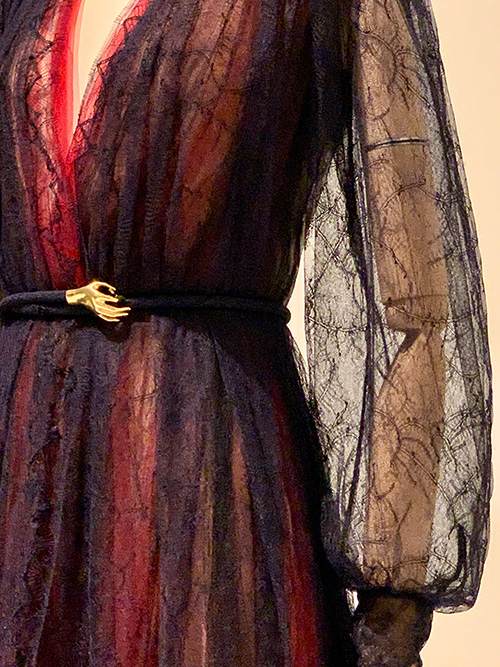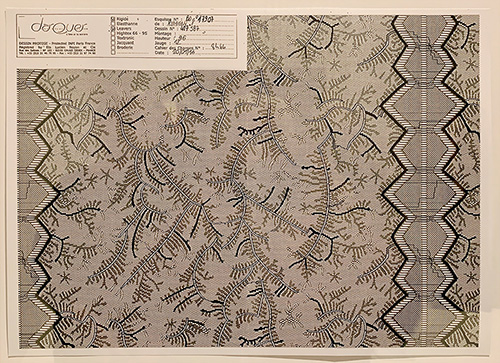
“Tears and Lace” of the Elsa Schiaparelli fashion house
When I read the recent TRC blog about Elsa Schiaparelli, I thought of the exhibition The Art of Lace (2020) in the TextileMuseum in Tilburg. This exhibition, adapted from an earlier exhibition called 'Haute Dentelle' mounted in Calais in 2018, was an ode to lace manufacturers, but also to the fashion houses that use lace. The curator then was Sylvie Marot.
The exhibition did not focus on handmade lace, but on machine made forms. The laces for the fashion industry were often specially designed and made for the couture houses. Lace factories, such as those of Solstiss in Caudry and Darquer Méry and Noyon Dentelles in Calais, still exist.
A number of Elsa Schiaparelli's dresses, with lace, were displayed in this exhibition. Schiaparelli's fashion house used different lace manufacturers. One of the dresses was made of lace and reflected a special story:
The design for the lace was based on a photograph from Rose-Lynn Fisher's series The Topography of Tears (2009). For this series, the artist studied her own tears through a microscope and took close-up photographs. The lace manufacturer Darquer had one of their lace designers, Vincent Fasquel, make a digital sketch of the photograph 'Last tear I ever cry for you', which was provided with a double scalloped edge by Fasquel's colleague, Frédéric Rumigny. Now the design was ready to be worked out by technical draftsmen for the machine. In 2015, a sample of the lace was made on their Leavers machine in the Chantilly technique.
 When the machine-made lace, by now called Tears and Lace, was presented to the Schiaparelli fashion house, they were immediately enthusiastic without knowing exactly the story of its origins.
The lace, black in colour, was used over a red dress belonging to the autumn-winter 2017/2018 collection. The dress was called 'Les vases communicants'. The tear drop pattern is very clearly visible on the sleeves, where the lace is almost undraped and therefore virtually transparent. The scalloped edges are clearly recognisable on the bottom edge and front of the dress.
When the machine-made lace, by now called Tears and Lace, was presented to the Schiaparelli fashion house, they were immediately enthusiastic without knowing exactly the story of its origins.
The lace, black in colour, was used over a red dress belonging to the autumn-winter 2017/2018 collection. The dress was called 'Les vases communicants'. The tear drop pattern is very clearly visible on the sleeves, where the lace is almost undraped and therefore virtually transparent. The scalloped edges are clearly recognisable on the bottom edge and front of the dress.
This article was originally publised on the TRC Blog on 31 december 2021.
A number of Elsa Schiaparelli's dresses, with lace, were displayed in this exhibition. Schiaparelli's fashion house used different lace manufacturers. One of the dresses was made of lace and reflected a special story:
The design for the lace was based on a photograph from Rose-Lynn Fisher's series The Topography of Tears (2009). For this series, the artist studied her own tears through a microscope and took close-up photographs. The lace manufacturer Darquer had one of their lace designers, Vincent Fasquel, make a digital sketch of the photograph 'Last tear I ever cry for you', which was provided with a double scalloped edge by Fasquel's colleague, Frédéric Rumigny. Now the design was ready to be worked out by technical draftsmen for the machine. In 2015, a sample of the lace was made on their Leavers machine in the Chantilly technique.
 When the machine-made lace, by now called Tears and Lace, was presented to the Schiaparelli fashion house, they were immediately enthusiastic without knowing exactly the story of its origins.
The lace, black in colour, was used over a red dress belonging to the autumn-winter 2017/2018 collection. The dress was called 'Les vases communicants'. The tear drop pattern is very clearly visible on the sleeves, where the lace is almost undraped and therefore virtually transparent. The scalloped edges are clearly recognisable on the bottom edge and front of the dress.
When the machine-made lace, by now called Tears and Lace, was presented to the Schiaparelli fashion house, they were immediately enthusiastic without knowing exactly the story of its origins.
The lace, black in colour, was used over a red dress belonging to the autumn-winter 2017/2018 collection. The dress was called 'Les vases communicants'. The tear drop pattern is very clearly visible on the sleeves, where the lace is almost undraped and therefore virtually transparent. The scalloped edges are clearly recognisable on the bottom edge and front of the dress.This article was originally publised on the TRC Blog on 31 december 2021.